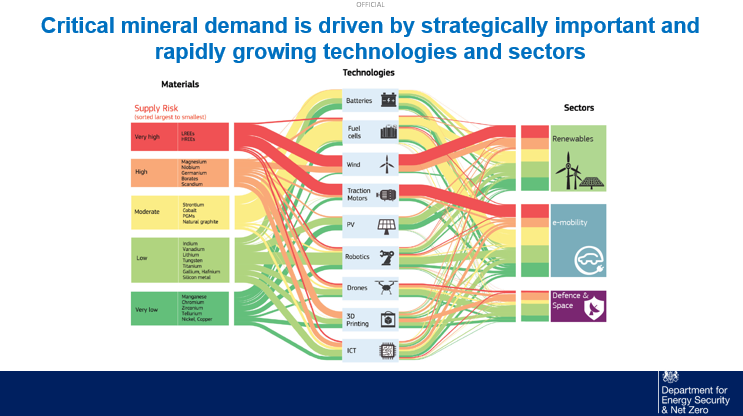FST JOURNAL
Critical Minerals
DOI: https://www.doi.org/10.53289/TERL8867
Critical Minerals: the key to a transitioning world
Professor Paul Monks

Professor Paul Monks CB is the Chief Scientific Adviser (CSA) for the Department for Energy Security and Net Zero (DESNZ). As CSA, he delivers independent and impartial science and engineering advice to Ministers and policy makers across the department’s policy and delivery portfolio and Clean Energy Superpower Mission. Paul also works closely with the Government CSA, the cross-government network of departmental CSAs, and the DESNZ Chief Analyst, to strengthen the links within and across departments, encouraging effective engagement and knowledge sharing, and to support delivery of a robust evidence base to underpin policy decisions.
Summary:
- It is important to understand what we mean by "critical minerals" and the implications of their extraction and use
- Critical Minerals often have complex supply chains; mined in one country, refined in another, and packaged in another
- The global geopolitical landscape has an impact on supply as these minerals are sourced from different countries
- The UK’s Critical Minerals strategy emphasises the importance of accelerating growth in the UK's domestic markets and collaborating with international partners.
A conventional car contains slightly less than 50 kilograms of copper wire, while an electric car contains approximately 11 kilometres of copper wire compared to just one kilometre in a conventional vehicle. This stark contrast highlights the significant differences in the technologies involved. We are also witnessing a transition toward various energy sources such as onshore and offshore wind, solar, nuclear, and natural gas. Notably, coal is no longer the incumbent technology in the UK, as we closed our last coal-fired power station on September 30th of last year. The chart shows that there are significantly more critical minerals involved in the power production of these renewable technologies compared to conventional ones.

What do we mean by Critical Minerals?
It is important to understand what we mean by "critical minerals" and the implications of their extraction and use. The global geopolitical landscape plays a significant role, as these minerals are sourced from various countries. Data from 2019 indicates a diverse range of mineral sources, each with differing production metrics and applications. However, it is inaccurate to view the story of critical minerals purely from the perspective of primary production. These minerals often have complex supply chains; they might be mined in one country, refined in another, and finally packaged and sold in yet another country. This movement highlights the importance of the value chain for these minerals. The extraction and refining processes for these minerals differ significantly from those for conventional energy sources like natural gas and oil. Additionally, the geographical distribution of these resources and their processing locations vary greatly across the globe. In response to this landscape, we produced the first UK's critical mineral strategy in 2022, acknowledging the need for resilience for the future. The strategy emphasises the importance of accelerating growth in the UK's domestic markets, collaborating with international partners, and enhancing international markets to promote responsible practices. To implement this strategy, we established a critical minerals expert committee and several initiatives to support these goals.
Markets
We must accelerate the growth of the UK's domestic markets and collaborate with international partners to enhance and make our international markets more responsible. During this process, we established two key initiatives: the Critical Minerals Expert Committee, and the Critical Minerals Intelligence Centre. These committees are among the best I have worked with, as they comprise a diverse mix of academia, industry economists, producers, and midstream financiers. This diversity allows us to obtain a comprehensive understanding of the critical minerals sector and emphasizes the UK's role as a hub for critical thinking on minerals. The Critical Minerals Intelligence Centre continuously monitors supply chains and projects future supply and demand.
A core aspect of our strategy focuses on economic vulnerability regarding the supply of minerals in the UK compared to global availability. Assessing criticality poses challenges, particularly in looking backward while also projecting forward. Currently, we are considering the assessment for late 2024, which expands from 18 or 20 to 34 minerals in our strategy, reflecting the evolving criticality of these materials and their applications within UK supply chains. Before we discuss upcoming changes to the strategy—typical of the government's approach—it is important to look at key components of the previous strategy. These include domestic production, skills development, research and development (R&D), and circular economy initiatives. While the UK has a limited supply of some minerals, we possess significant knowledge and skills, along with some of the world's top R&D in this area. We are focused on promoting circularity and diversifying supply chains by collaborating with UK companies operating overseas. Our diplomatic, trading, and development relationships have been effective; I have worked with our partners who are engaged with British industry in various supplier and processing countries. We also recognise the necessity of responsible operations, adhering to the highest Environmental, Social, and Governance (ESG) standards.
Moving forwards
The sector has a checkered history regarding these issues, and consumers are increasingly demanding ethical practices. No one wants to see child labour involved in mining minerals for their vehicles. The London market is one of the largest mining finance markets globally, and we have achieved several successes. Recently, the National Government invested £28 million in Cornish Metals, while the UK Infrastructure Bank added approximately £24 million in equity investment to Cornish Lithium. New companies, such as Green Lithium in the Northeast, are emerging alongside established entities like Pensana and Rare Earths, which are involved in reprocessing rare earth magnets. Additionally, innovative firms like Hyper Mac [C2] are pioneering hydrogen recycling methods to recover rare earth magnets from computer disk drives. While we have made significant strides in innovation and R&D, as demonstrated by projects like the Climates initiative, which seeks to build a more sustainable supply chain in rare earths, we continue to invest heavily in this area. One of the UK's real strengths is its international partnerships. We are recognized as a fair broker in many discussions, and during my international missions, various countries express interest in accessing our skills and R&D capabilities. We have established several bilateral agreements, which are listed on the screen, and are actively engaged in multilateral initiatives. A notable example includes the Mineral Security Partnership, which is heavily led by the US, and we anticipate changes to this partnership as we proceed.
I have provided an overview of the importance of minerals in our changing world. As we work towards decarbonisation, these minerals become increasingly vital. They are globally mobile and extracted from the earth, but it's the midstream processes that facilitate their movement. We need a comprehensive strategy that incorporates all the elements shown on this screen to ensure safety, security, and economic growth in this sector.
